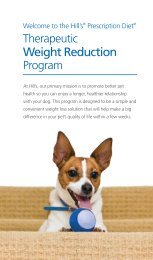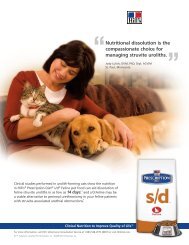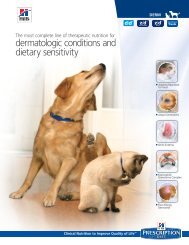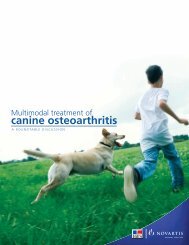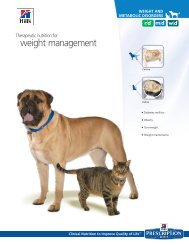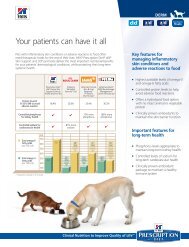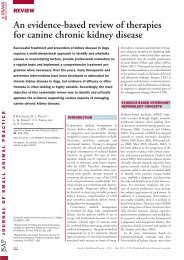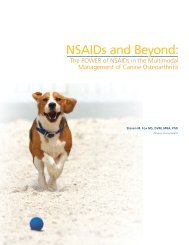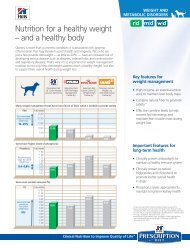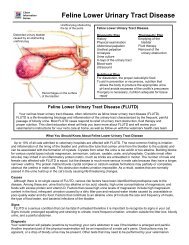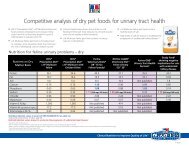using nutrition to ease the pain of osteoarthritis - HillsVet
using nutrition to ease the pain of osteoarthritis - HillsVet
using nutrition to ease the pain of osteoarthritis - HillsVet
Create successful ePaper yourself
Turn your PDF publications into a flip-book with our unique Google optimized e-Paper software.
<strong>nutrition</strong> myths and truths, facts and fallacies<br />
Chondroitin Sulfate (CS) is <strong>the</strong> predominant glycosaminoglycan found in articular cartilage. Bioavailability<br />
studies have shown 70% absorption <strong>of</strong> CS following oral administration. The effect <strong>of</strong> CS on cartilage has been<br />
investigated in several in vivo and in vitro studies. The findings suggest that CS reduces collagenolytic activity,<br />
inhibits degradative enzymes, incr<strong>ease</strong>s hyaluronate concentrations, and reduces symp<strong>to</strong>ms <strong>of</strong> OA. Most<br />
research indicates that glucosamine and chondroitin sulfate work synergistically. Numerous studies performed<br />
on one such combination (Cosequin ® Nutrimax Labora<strong>to</strong>ries, Inc.) have demonstrated improved syn<strong>the</strong>sis <strong>of</strong><br />
glycosaminoglycans and reduced proteolytic activity. Clinical trials have repeatedly shown a positive clinical<br />
effect in OA patients.<br />
Injectable dis<strong>ease</strong>-modifying OA agents are also available, <strong>the</strong> most common one used in dogs being Adequan ® *<br />
(used under license, Novartis Animal Health). Adequan is a polysulfated glycosaminoglycan (PSGAG), and studies<br />
have shown it has a positive anabolic effect on cartilage and decr<strong>ease</strong>s cartilage catabolism.<br />
Anti-inflamma<strong>to</strong>ry and analgesic medications (NSAIDs): NSAIDs are used because <strong>of</strong> <strong>the</strong>ir ability <strong>to</strong><br />
reduce joint <strong>pain</strong> and decr<strong>ease</strong> synovitis. A variety <strong>of</strong> NSAIDs are available for use in animals and are effective,<br />
in part, by decreasing prostaglandin syn<strong>the</strong>sis through <strong>the</strong> inhibition <strong>of</strong> cyclooxygenase (COX). Newer NSAIDs<br />
have been shown <strong>to</strong> have no detrimental affect on <strong>the</strong> syn<strong>the</strong>sis <strong>of</strong> cartilage proteoglycans in vitro at <strong>the</strong><br />
recommended dosing. Drugs commonly used <strong>to</strong> control <strong>pain</strong> in dogs with OA include acetaminophen (15 mg/<br />
kg q 8h), carpr<strong>of</strong>en (4.4 mg/kg q 24h), e<strong>to</strong>dolac (10-15 mg/kg q 24h), meloxicam (0.1 mg/kc q 8h), deracoxib<br />
(1-2 mg/kg q 24h), and tepoxalin (10mg/kg q 24h) among o<strong>the</strong>rs. It is important <strong>to</strong> recognize that individual<br />
patients respond <strong>to</strong> specific NSAIDs quite differently.<br />
Corticosteroid treatment for OA remains controversial. Corticosteroids decr<strong>ease</strong> <strong>the</strong> production <strong>of</strong> arachidonic<br />
acid, are potent anti-inflamma<strong>to</strong>ry agents, and decr<strong>ease</strong> catabolic activity within <strong>the</strong> joint. However,<br />
corticosteroids may also damage cartilage (with long-term usage) by decreasing syn<strong>the</strong>sis <strong>of</strong> collagen and<br />
matrix proteoglycans.<br />
Summary<br />
Although prevention <strong>of</strong> <strong>osteoarthritis</strong> is ideal, it is not always possible. Because <strong>osteoarthritis</strong> is a heterogeneous<br />
dis<strong>ease</strong> with diverse origins, it can present with a range <strong>of</strong> clinical manifestations. As a result, <strong>the</strong>rapeutic<br />
recommendations should be cus<strong>to</strong>mized for each patient. When appropriate, surgical correction <strong>of</strong> underlying<br />
conditions should be considered. After <strong>osteoarthritis</strong> is diagnosed, clients should be educated <strong>to</strong> foster<br />
realistic expectations. Osteoarthritis is usually irreversible but good management can minimize <strong>pain</strong> and slow<br />
progression <strong>of</strong> <strong>the</strong> dis<strong>ease</strong>. The goals <strong>of</strong> management include:<br />
✔ mitigation <strong>of</strong> risk fac<strong>to</strong>rs<br />
✔ controlling clinical signs<br />
✔ slowing progression <strong>of</strong> <strong>the</strong> dis<strong>ease</strong>.<br />
Thus, effective treatment requires a multimodal approach, <strong>of</strong> which <strong>the</strong>rapeutic <strong>nutrition</strong> is an important<br />
component. The goals <strong>of</strong> <strong>nutrition</strong>al management include reducing inflammation and <strong>pain</strong>, enhancing cartilage<br />
repair, slowing cartilage degradation and providing tangible improvement in clinical signs <strong>of</strong> <strong>osteoarthritis</strong>.<br />
Foods designed for patients with <strong>osteoarthritis</strong> should supply age-appropriate <strong>nutrition</strong> and specific nutrients<br />
that may help reduce inflammation and <strong>pain</strong>, slow <strong>the</strong> degradative process, complement prescribed medications<br />
and provide tangible improvement in clinical signs.<br />
* As with all drugs in this class, side effects involving <strong>the</strong> digestive system, kidneys or liver may occur. These are normally mild, but may be serious. Pet owners should<br />
discontinue <strong>the</strong>rapy and contact <strong>the</strong>ir veterinarian immediately if side effects occur. Evaluation for pre-existing conditions and regular moni<strong>to</strong>ring are recommended<br />
for pets on any medication, including Adequan. ® Use with o<strong>the</strong>r NSAIDs or corticosteroids should be avoided.



